Tips for your Safety while Trekking!!
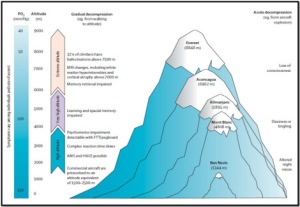 Trekking in the mountains is a rewarding and unforgettable experience. However, it is important to keep your safety in mind. Weather conditions can change any moment and in case of an accident, medical help is not always easily available. Have a look below for some guidelines and tips on health & safety during your trip. Keeping those in mind will also help you to enjoy your trip more!
Trekking in the mountains is a rewarding and unforgettable experience. However, it is important to keep your safety in mind. Weather conditions can change any moment and in case of an accident, medical help is not always easily available. Have a look below for some guidelines and tips on health & safety during your trip. Keeping those in mind will also help you to enjoy your trip more!
Preparation:
- Read about the destination you are going to and make sure you know the details of your trek.
- Make sure you have proper clothing for all weather conditions (warm clothes, rain gear and hat, scarf and gloves).
- Make sure you have the necessary (mountain) equipment suitable for the specific terrain.
- Be prepared for challenging weather conditions, especially if you go trekking in high altitude areas (above 3,000 m/10,000 ft). “Wind chillâ€Â, the combined effects of high winds and cold air, can dramatically lower the body temperature. This is dangerous and potentially fatal. It is therefore very important to be properly equipped when walking high up in the mountains in bad weather.
- If you go trekking in altitudes above 3,000 m (10,000 ft), inform yourself about altitude sickness (more info below).
- Make sure someone knows your trekking itinerary and when you are supposed to be back from your trek.
- Make sure you are properly insured and take your insurance details with you, including emergency numbers. Leave your insurance details with somebody at home as well.
- Take your mobile phone with you; if you go to very remote places, you may consider taking a satellite phone.
- Especially if you go without a guide, make sure you know the basics of first aid.
- Carry a whistle with you (if you get lost, it is easier to get attention with a whistle).
While trekking:
- Never walk alone, go with a friend or porter/guide.
- Always carry warm clothes and rain gear with you.
- Always carry a first aid kid with you.
- Always carry enough water and snacks; make sure you know when you can restock/refill your water.
- Always carry a torch (and spare batteries) with you.
- Personal hygiene is important in order not to get sick: always wash your hands after using the toilet and before eating (if no water and soap is available, use disinfecting gel).
- If possible, try to get information about the weather forecast.
- You will regularly encounter (caravans of) mules or yaks during your treks in the Himalayas: stay on the mountain side while you wait for them to pass and don’t go too close to the ridge. The animals usually carry heavy and wide loads and they might kick you off the mountain if you don’t watch out!
- In warm weather, the principle hazards are sunburn, windburn and dehydration. Sunhats, sun cream, and ample water can prevent serious sunburn or heatstroke.
- Make sure you have a map and compass and/or GPS and know how to use it (especially if you go without a porter/guide).
- Don’t take unnecessary risks by taking overly long or difficult routes.
- As far as possible register yourself in the guesthouse/homestay where you stay and/or tell where you are going next.
If going with a guide or porter:
- Share your insurance details with your guide/porter/travel company.
- Listen to the advice of your guide/porter, who knows more about the specific conditions of the trek.
Altitude Sickness/Acute Mountain Sickness (AMS) 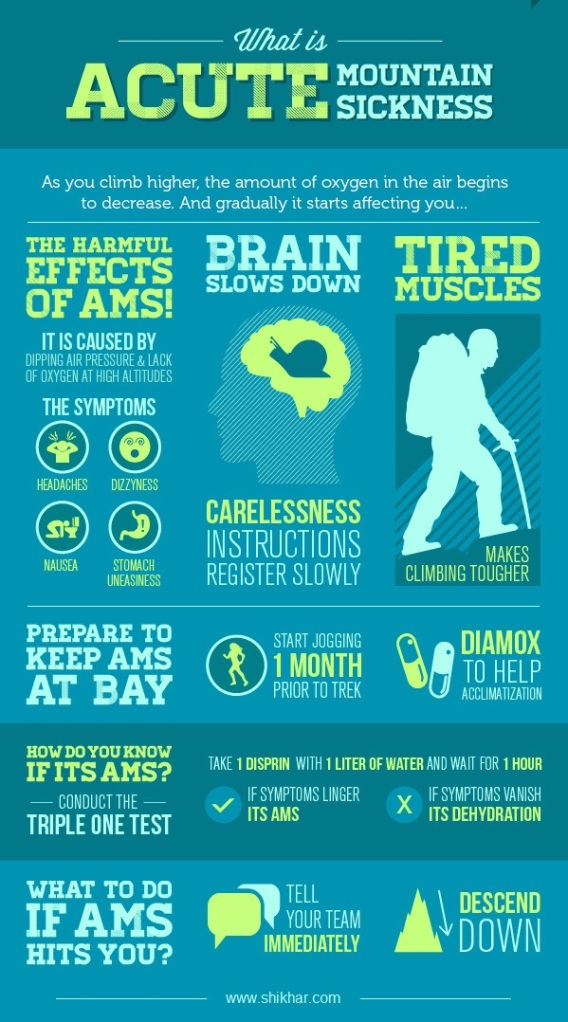
Altitude sickness, also called Acute Mountain Sickness (AMS) generally occurs above 2,500 m (8,000 ft), but serious altitude illness is rare below 3,000 m (10,000 ft). It ranges from perspiration a mild headache and weariness to a life-threatening disease, when fluid in the lungs (HAPE) or brain (HACE) is built-up. AMS is caused by the body having difficulty adapting to the lower oxygen level at higher altitudes. Usually this is due to a too quick ascent, and sometimes personal sensitivity. As AMS can be fatal, it is important to know about the disease, its symptoms, how to prevent them and how to treat AMS.
Acute Altitude Sickness:
Acute altitude sickness is the mildest and most common form. Patients usually have a (mild) headache and/or less appetite, and nausea. These symptoms are quite common above 3,000 meters (10,000 ft). Nothing to be worried about (yet), but it is important to tell you guide or trekking companion about your symptoms, and keep close watch that they don’t get worse.
Symptoms:
- Headache.
- Fatigue.
- Dizziness.
- Insomnia.
- Shortness of breath during exertion.
- Nausea.
- Decreased appetite.
- Swelling of extremities.
- Lack of sleep.
- Social withdrawal.
High Altitude Pulmonary Edema (HAPE) 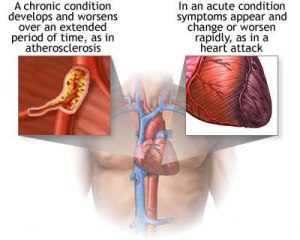
HAPE occurs when fluid builds up within the lungs, a condition that can make breathing extremely difficult. Onset of HAPE can be gradual or sudden. HAPE typically occurs after more than one day spent at high altitude. If left untreated, it can progress to respiratory collapse and ultimately to death.
Symptoms:
- Shortness of breath at rest.
- Extreme fatigue.
- Gurgling respirations.
- Dry cough or wet cough with frothy sputum.
- Possible fever.
- Respiratory failure.
High Altitude Cerebral Edema (HACE)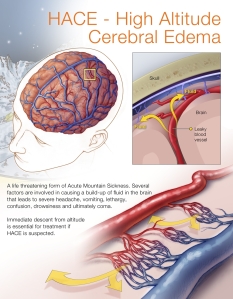
Another severe form of altitude sickness is high altitude cerebral edema (HACE), in which fluid builds up within the brain. As the brain swells with fluid, the person’s mental state changes. Loss of coordination, coma, and, finally, death can are the cause if not recognized and treated promptly.
Symptoms:
- Difficulty with balance and coordination.
- Hallucinations, lethargy, confusion.
- As the brain continues to swell unconsciousness or coma will develop.
How to identify if someone is seriously suffering from AMS, HAPE or HACE:
- Ask the person to close his eyes and bring his finger to the tip of his nose.
- Ask the person to walk in a straight line
- Ask the person to put on pants (put his leg into one of the legs)
If he is not able to do so, the situation is serious!!
How to treat AMS: 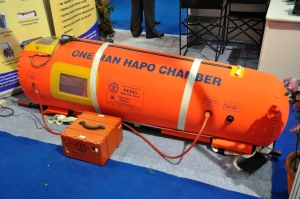
- In case of mild symptoms, stay at the same altitude. Ascend only when the symptoms have resolved completely.
- In case your symptoms are getting worse while resting at the same altitude, descend.
- In case of serious symptoms go down immediately! Helicopter rescue may be necessary.
- If the patient is not able to walk (due to serious symptoms) and can’t be carried down, an inflatable high pressure bag (Gamow Bag) can help. The bag restores the oxygen level and air pressure and is used as a treatment in acute situations. Some trekking groups carry a pressure bag, besides they are available in some lodges, especially in the Khumbu/Everest area.
- Never let a patient descend unattended.
- If available, consult a doctor, also if symptoms are not yet very serious.
How to prevent AMS:
The best way to prevent AMS is to ascend gradually. Above an altitude of 3,000 meters (10,000 ft) you should not ascend more than 300 m (1,000 ft) a day. If due to the itinerary this is not possible, a rest day to acclimatize recommended. Drinking lots of water can help to prevent AMS. Per day, you should be drinking 1 liter of water for every 1,000 meter (3,000 ft) altitude. This means that at an altitude of 4,000 m (12,000 ft), you should be drinking 4 ltrs of water a day (or tea, juice or other fluids, except alcohol).
More and more people use Diamox (Acetazolamide) as a prophylaxis, to help the body acclimatize more quickly. You start taking Diamox shortly before you start to ascend above 3,000 m (10,000 ft) and continue taking it untill you descend again. Consult with your doctor if you consider using Diamox. Persons with allergy to sulfa drugs should not take the drug. Drink extra amounts of water, as Diamox dehydrates the body.

You have written a very good article, I have been reading your website for a long time, each of your articles has some special and good information. You always kept writing like this. Tell me something about the destination given below. Thank you. Kareri Lake Trek
thanks for sharing the tips